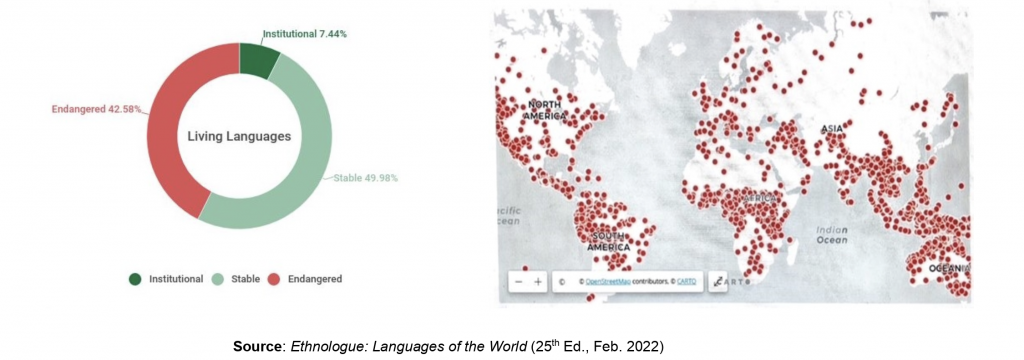In our last session in the course “Demarginalising Orature – Translating minor forms into the digital age” we talked a lot about culture and language, their relation to folktales, and also how important folktales are in order to preserve them. Almost every folktale comes from an oral source, having been passed down through generations by word of mouth, and carries a lot of cultural meaning and importance for the communities that they are told in. They are also region-specific or community-specific, varying between various languages and dialects that therefore also hold cultural meaning.
By passing on folktales, whether in the written or oral form, the cultures and languages they derive from are preserved. We were shown a map of the world, its languages, and how many were believed to go extinct soon.

As the map shows, almost half of the languages from today – spanning all continents – might go extinct soon, and one way of documenting them for the future is by preserving them through the documentation of folktales. Folktales are a source of indigenous knowledge and hence transmit the culture and language of a community. This is, because folktales include lessons about moral and values, often very specific to the culture they are deriving from. The example we had for this in class was a Konkomba folktale called ‘Why the Wasp Has a Tiny Waist’. It is a folktale that gives lessons about communal activities and the cultural traditions after someone, especially an in-law, has died in the Konkomba community. Without the knowledge of the culture a listener might not fully understand the folktale and its moral and values, but by telling it this aspect of the culture is preserved.
And language, of course, is also a part of culture. But when it comes to languages that are not institutionalized, the best way to make it accessible, visible and preserve it is by translating it into an institutionalized language. But for the original language to still be preserved and made visible – because by hearing a folktale the listener also gets a feeling about the language – to foreignize the translation and thereby giving visibility to the original language and culture is the best way of doing so.
Hence, folktales encompass cultures and languages and by documenting and preserving them, their cultures and language will be accessible for forever. A difficulty in trying to preserve languages and cultures is, that there needs to be someone to go to these regions, record these folktales, translate them, and preserve them in some way. This project on Konkomba folktales is a step in this direction, but there are so many regions, as shown in the map, that it will need a lot of dedication from many different people for this preservation to happen on a broader scale.

4 thoughts on “Folktales: On the Preservation of Culture and Language”